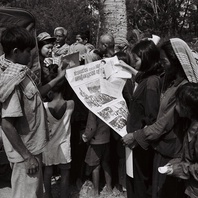
Featured Item
Villagers looking at a poster
This (probably staged) photograph shows a group of villagers looking at an illustrated poster about the Kampuchea United Front for National Salvation (KUFNS, also known as FUNSK) [Front or Renakse]. It is part of a series that describes the same group of villagers and soldiers. This photograph is part of the collection held by the Agence Khmère de Presse (AKP) and Cambodia’s Ministry of Information. This collection, which documents the early years of the People’s Republic of Kampuchea as photographed by the Vietnamese and a small team of Cambodian photographers, has not yet been classified or indexed.
Read More
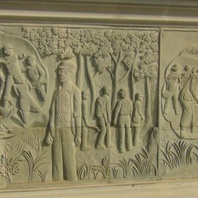
Item
Win-Win Monument bas-relief
This photograph provides a view of bas-relief on the 117-metre-long engraved base of the Win-Win Monument. It depicts the defection to Vietnam of the then Khmer Rouge officer Hun Sen in June 1977. One sees Hun Sen (dressed in Khmer Rouge garb) considering what may happen to him and his group of defectors (being killed) if they are caught by the Khmer Rouge. It also shows Hun Sen thinking about his wife who he left behind. The Win-Win Monument complex – photographed here in January 2020 – was inaugurated in December 2018 to mark the twentieth anniversary of the end of the post-Democratic Kampuchea civil war, with the final defection of the remaining Khmer Rouge factions, thanks to the DIFID policy (“Divide, Isolate, Finish, Integrate, Develop”) also known as the “Win Win” policy of Prime Minister Hun Sen.
Read More
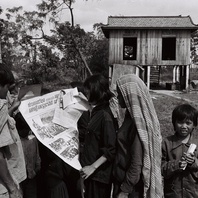
Featured Item
Village children looking at a poster
This (probably staged) photograph shows a group of village children looking at an illustrated poster celebrating the Kampuchea United Front for National Salvation (KUFNS, also known as FUNSK) [Front or Renakse]. It is part of a series that describes the same group of villagers and soldiers. This photograph is part of the collection held by the Agence Khmère de Presse (AKP) and Cambodia’s Ministry of Information. This collection, which documents the early years of the People’s Republic of Kampuchea as photographed by the Vietnamese and a small team of Cambodian photographers, has not yet been classified or indexed.
Read More
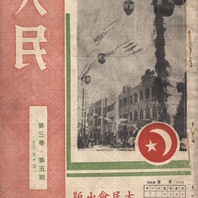
Item
Damin cover image, May 1940
This is the cover image of the magazine Damin 3.3 (May 1940), published by the Daminhui (Great People’s Association) in Nanjing. The Daminhui was a propaganda and mobilization organization established by the Japanese in 1938, which was later folded into Wang Jingwei’s Kuomintang (Nationalist Party). The Daminhui specialised in public expressions of support for the occupation, and employed a staff of Chinese organisers, artists, and writers. The sun-and-moon logo of the Daminhui can be seen on this magazine’s cover.
Read More
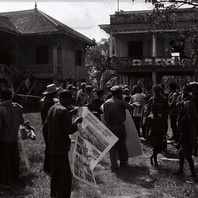
Featured Item
Posters being distributed to villagers
This photograph shows soldiers distributing illustrated posters celebrating the Kampuchea United Front for National Salvation (KUFNS, also known as FUNSK) [Front or Renakse] to a group of villagers. It is part of a series that describes the same group of villagers and soldiers. This photograph is part of the collection held by the Agence Khmère de Presse (AKP) and Cambodia’s Ministry of Information. This collection, which documents the early years of the People’s Republic of Kampuchea as photographed by the Vietnamese and a small team of Cambodian photographers, has not yet been classified or indexed.
Read More
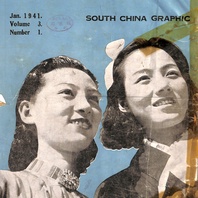
Item
Huanan huabao (South China Graphic) cover, January 1941
This cover image is taken from Huanan huabao (South China graphic) 3.1 (January 1941). The staged photograph deploys one of the standard tropes of Japanese propaganda in occupied China, i.e., that of a Japanese woman and Chinese woman fraternising with each other. This trope was derived from Manchukuo propaganda and the notion of “gozoku kyōwa” (“the harmony of the five races”), as well as attempts to feminise the image of an occupied China. Note how the Japanese woman is pictured as being slightly higher than her Chinese peer.
Read More
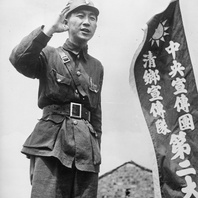
Item
Rural Pacification cadre making a speech
Photograph of a member of the RNG Central Propaganda Group’s Number 2 Rural Pacification Propaganda Team as he addresses a rural audience. The photograph was possibly produced by the RNG’s Central News Agency, which increased its capacity for photography in 1942 to compete with the propaganda work of Chiang Kai-shek’s Nationalists in Chongqing.
Read More
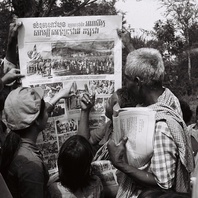
Featured Item
Villagers and soldiers pointing at poster
This (probably staged) photograph shows a group of villagers and soldiers reading an illustrated, A0-size propaganda poster celebrating the Kampuchea United Front for National Salvation (KUFNS, also known as FUNSK) [Front or Renakse]. The image provides a clear view of the poster and the photos on it. The poster’s title reads: “Fight for the Front” (or, more literally, “rush and struggle under the front’s flag”). The photos on the poster have captions in Khmer. One of the older villagers holds the upper right-hand corner of the poster. He has a folded poster in his other hand. Next to him, a young boy points his finger at the top picture, which shows the founding of the Kampuchea United Front for National Salvation in Kratie in December 1978. A female soldier points her finger at the caption below the picture. This photograph is part of the collection held by the Agence Khmère de Presse (AKP) and Cambodia’s Ministry of Information. This collection, which documents the early years of the People’s Republic of Kampuchea as photographed by the Vietnamese and a small team of Cambodian photographers, has not yet been classified or indexed.
Read More
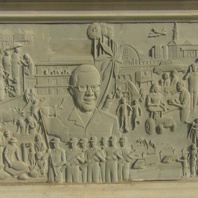
Item
Win-Win Monument bas-relief
This photograph provides a view of the bas-relief on the 117-metre-long engraved base of the Win-Win Monument. It depicts the rebirth of Cambodia after 1979 with different sectors being represented (religion, agriculture, transport, etc.). Hun Sen is featured in the middle, and is larger in sizes than other figures. The Win-Win Monument complex – photographed here in January 2020 – was inaugurated in December 2018 to mark the twentieth anniversary of the end of the post-Democratic Kampuchea civil war, with the final defection of the remaining Khmer Rouge factions, thanks to the DIFID policy (“Divide, Isolate, Finish, Integrate, Develop”) also known as the “Win Win” policy of Prime Minister Hun Sen.
Read More
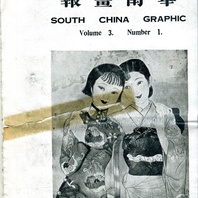
Item
Huanan huabao (South China Graphic) inside cover, January 1941
This image is taken from Huanan huabao (South China graphic) 3.1 (January 1941). The illustration deploys one of the standard tropes of Japanese propaganda in occupied China, i.e., that of a Japanese woman and Chinese woman fraternising with each other. This trope was derived from Manchukuo propaganda and the notion of “gozoku kyōwa” (“the harmony of the five races”), as well as attempts to feminise the image of an occupied China. Note how the Japanese woman is pictured as being slightly higher than her Chinese peer.
Read More
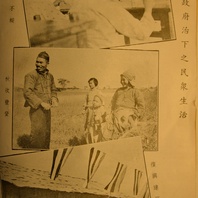
Item
Weixin zhengfu zhixia zhi minzhong shenghuo (The life of the masses under the Reformed Government)
This series of unattributed photographs is taken from the Daminhui publication Xin Zhongguo (New China) 3.1 (January 1940). They are used here to present scenes of life under the rule of the Reformed Government (Weixin zhengfu), or RGROC, which was a “client regime” established in 1938. The RGROC was eventually amalgamated with Wang Jingwei’s RNG in March 1940. The top image is entitled “xian’ge bu chuo” (“studying never stops, even in times of strife”); the middle image is entitled “qiu shou fengdeng” (gathering the autumn harvest); the image at the bottom of the page is entitled “fuxing jianzhu” (renovating buildings). All three are typical images of the sort that the Daminhui promoted in the period between 1938 and 1940, but also display a clear influence from Manchukuo propaganda photography from earlier in the 1930s.
Read More
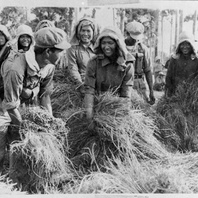
Featured Item
Soldier helping with harvest
This staged and unattributed photographs shows a soldier of the Kampuchea United Front for National Salvation (KUFNS, also known as FUNSK) [Front or Renakse] helping a group of women to harvest crops. In the foreground, the soldier, with his rifle on his back, makes a large sheaf. He looks at the woman on his left. This photograph is part of the collection held by the Agence Khmère de Presse (AKP) and Cambodia’s Ministry of Information. This collection, which documents the early years of the People’s Republic of Kampuchea as photographed by the Vietnamese and a small team of Cambodian photographers, has not yet been classified or indexed.